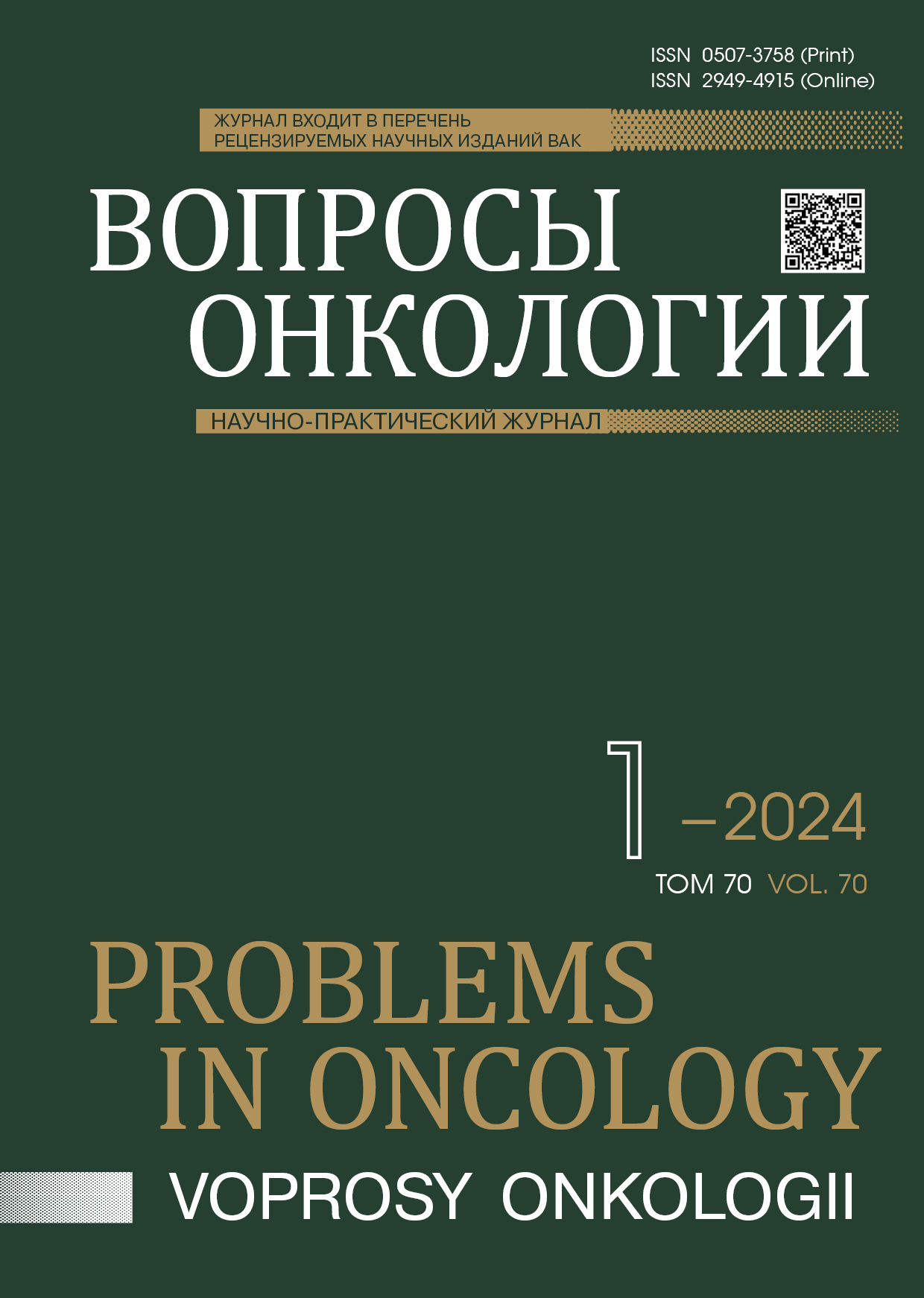Аннотация
Цель — изучить влияние тиреостатика пропилтиоурацила (ПТУ) на продолжительность жизни крыс с глиомой С6.
Материалы и методы. Моделирование опухоли головного мозга in vivo выполняли с помощью внутримозговой стереотаксической имплантации крысам (n = 32) клеток глиомы С6. Животных рандомизировали на 2 группы в соотношении 9:7. На крысах экспериментальной группы (n = 18) моделировали гипотиреоз путем перорального зондового введения пропилтиоурацила 15 мкл на животное 1 раз в сутки.
Результаты. Введение припилтиоурацила достоверно (χ2 = 16,91, p = 0,001) на 63,16 % увеличивает продолжительность жизни крыс (n = 18, 16,0 ± 2,37 сут.) по сравнению с контролем (n = 14, 10,0 ± 4,2 сут.) и уменьшает риск их летального исхода (HR = 0,14, 0,05-0,38).
Выводы. Введение пропилтиоурацила увеличивает продолжительность жизни крыс с глиомой С6 и уменьшает риск летального исхода.
Библиографические ссылки
Davis M.E. Glioblastoma: Overview of Disease and Treatment. Clin J Oncol Nurs. 2016; 20(5 Suppl): 2-8.-DOI: https://doi.org/10.1188/16.CJON.S1.2-8.
Ou A., Yung W.K.A., Majd N. Molecular mechanisms of treatment resistance in glioblastoma. Int J Mol Sci. 2020; 22(1): E351.-DOI: https://doi.org/10.3390/ijms22010351.
Nauman P. Thyroid hormones in the central nervous system (CNS) and their effect on neoplasm formation, particularly on the development and course of glioblastoma multiforme - research hypothesis. Endokrynol Pol. 2015; 66(5): 444-59.-DOI: https://doi.org/10.5603/EP.2015.0055.
Farwell A.P., Dubord–Tomasetti S.A., Pietrzykowski A.Z., et al. Regulation of cerebellar neuronal migration and neurite outgrowth by thyroxine and 3,3',5'-triiodothyronine. Brain Res Dev Brain Res. 2005; 154(11): 121-135.-DOI: https://doi.org/10.1016/j.devbrainres.2004.07.016.
Farwell A.P., Tranter M.P., Leonard J.L. Thyroxine-dependent regulation of integrin-laminin interactions in astrocytes. Endocrinology. 1995; 136(9): 3909-15.-DOI: https://doi.org/10.1210/en.136.9.3909.
Trentin A.G., De Aguiar C.B., Garcez R.C., Alvarez-Silva M. Thyroid hormone modulates the extracellular matrix organization and expression in cerebellar astrocyte: effects on astrocyte adhesion. Glia. 2003; 42: 359-69.-DOI: https://doi.org/10.1002/glia.10228.
Moeller L.C., Führer D. Thyroid hormone, thyroid hormone receptors, and cancer: a clinical perspective. Endocr Relat Cancer. 2013; 20(2): R19-29.-DOI: https://doi.org/10.1530/ERC-12-0219.
Zhang L., Cooper-Kuhn C.M., Nannmark U., et al. Stimulatory effects of thyroid hormone on brain angiogenesis in vivo and in vitro. J Cereb Blood Flow Metab. 2010; 30(2): 323-335.-DOI: https://doi.org/10.1038/jcbfm.2009.216.
Gilbert M.E., Paczkowski C. Propylthiouracil (PTU)-induced hypothyroidism in the developing rat impairs synaptic transmission and plasticity in the dentate gyrus of the adult hippocampus. Brain Res Dev Brain Res. 2003; 145(1): 19-29.-DOI: https://doi.org/10.1016/s0165-3806(03)00191-3.
Wémeau J.L., Pigeyre M., Proust-Lemoine E., et al. Beneficial effects of propylthiouracil plus L-thyroxine treatment in a patient with a mutation in MCT8. J Clin Endocrinol Metab. 2008; 93(6): 2084-8.-DOI: https://doi.org/10.1210/jc.2007-2719.
Lefauconnier J.M., Lacombe P., Bernard G. Cerebral blood flow and blood-brain influx of some neutral amino acids in control and hypothyroid 16-day-old rats. J Cereb Blood Flow Metab. 1985; 5(2): 318-26.-DOI: https://doi.org/10.1038/jcbfm.1985.41.
Sunitha Y., Udaykumar P., Raghunath M. Changes in blood-brain barrier nutrient transport in the offspring of iodine-deficient rats and their preventability. Neurochem Res. 1997; 22(7): 785-90.-DOI: https://doi.org/10.1023/a:1022023524106.
Davis P.J., Lin H.Y., Hercbergs A.A., et al. How thyroid hormone works depends upon cell type, receptor type, and hormone analogue: implications in cancer growth. Discov Med. 2019; 27(147): 111-117.
Shinderman-Maman E., Cohen K., Weingarten C., et al. The thyroid hormone-αvβ3 integrin axis in ovarian cancer: regulation of gene transcription and MAPK-dependent proliferation. Oncogene. 2016; 35: 1977-1987.-DOI: https://doi.org/10.1038/onc.2015.262.
Davis F.B., Tang H.Y., Shih A. et al. Acting via a cell surface receptor, thyroid hormone is a growth factor for glioma cells. Cancer Res. 2006; 66(14): 7270-7275.-DOI: https://doi.org/10.1158/0008-5472.CAN-05-4365.
Liappas A., Alexandros L., Mourouzis I., et al. Cell-type-dependent thyroid hormone effects on glioma tumor cell lines. J Thyroid Res. 2011; 2011: 856050.-DOI: https://doi.org/10.4061/2011/856050.
Jones S.A., Jolson D.M., Cuta K.K., et al. Triiodothyronine is a survival factor for developing oligodendrocytes. Mol Cell Endocrinol. 2003; 199(1-2): 49-60.-DOI: https://doi.org/10.1016/S0303-7207(02)00296-4.
Faghih-Jouybari M., Naderi S., Mashayekhi S., et al. Hypothyroidism among patients with glioblastoma multiforme. Iran J Neurol. 2018; 17(3): 149-151.
Hercbergs A.A., Suh J.H., Lee S., et al. Propylthiouracil-induced chemical hypothyroidism with high-dose tamoxifen prolongs survival in recurrent high grade glioma: a phase I/II study. Anticancer Res. 2003; 23(1B): 617-626.
Linetsky E., Hercbergs A., Dotan S. Time to tumor progression (TTP) and quality of life (QOL) following propylthiouracil induction of chemical hypothyroidism in failed malignant gliomas (Abstract # 144). In: World Federation of Neuro-Oncology – Second Quadrennial Meeting. Edinburgh. 2005: 318.
Ashur-Fabian O., Blumenthal D.T., Bakon M., et al. Long-term response in high-grade optic glioma treated with medically induced hypothyroidism and carboplatin: a case report and review of the literature. Anticancer Drugs. 2013; 24(3): 315-323.-DOI: https://doi.org/10.1097/CAD.0b013e32835c7a47.

Это произведение доступно по лицензии Creative Commons «Attribution-NonCommercial-NoDerivatives» («Атрибуция — Некоммерческое использование — Без производных произведений») 4.0 Всемирная.
© АННМО «Вопросы онкологии», Copyright (c) 2024

